Content
- 1 What mushrooms can be grown at home
- 2 Growing technology for beginners
- 3 Other ways to grow mushrooms at home
- 4 Advice
- 5 What do you need
- 6 Substrate selection
- 7 Mycelium or fungal spores?
- 8 Preparation of the culture medium
- 9 Requirements for growing conditions
- 10 Mushrooms on the tree
- 11 Alternative way
- 12 The technology of growing mushrooms at home
- 13 Cultivation of champignon mushrooms
- 14 Growing oyster mushrooms
- 15 Growing shiitake mushrooms
- 16 Cultivation of porcini mushrooms
- 17 Growing Kombucha
There are more than enough mushroom lovers in our country! Only for a hike into the forest for a "quiet hunt" you need the accompanying weather and certain climatic conditions. Not everyone will think about growing mushrooms at home, and even almost on an industrial scale. Most consider this to be fantastic. However, everything is real. And we will tell you how to grow mushrooms in a greenhouse or at home.
What mushrooms can be grown at home
The very idea of growing mushrooms at home poses a choice of a specific species. All varieties suitable for home breeding do not need special material costs or additional efforts. The only exceptions are champignons, but an experienced gardener will cope with this problem too. The choice must be made, first of all, based on the desired profit. All varieties of mushrooms suitable for growing at home can be classified into two main types:
- woody;
- soil.
The former include the well-known shiitake mushrooms, oyster mushrooms, and winter mushrooms. But to the second - no less popular mushrooms and ringlets. Even with small areas, the harvest can be excellent. That is why these varieties are recommended for growing on an industrial scale.
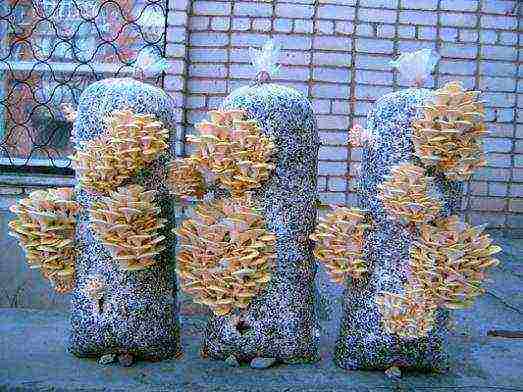 Growing oyster mushrooms at home on the balcony
Growing oyster mushrooms at home on the balcony
Growing technology for beginners
The bulk of the time it takes to grow mushrooms is spent creating mycelium. However, the advice of experienced mushroom growers suggests that it is better to grow this material on your own. After all, even the best and trusted suppliers fail from time to time. Mycelium can be grown in two ways:
- in the grain substrate;
- on wooden sticks.
The choice depends on what kind of mushrooms you plan to grow.
 Growing mushrooms on a nutritious substrate
Growing mushrooms on a nutritious substrate
Breeding mycelium
The mycelium is grown in a specific substrate. It is recommended to make sure that its chemical and mineral composition is as similar as possible to that in which mushrooms grow naturally. The composition of this medium must be selected again, depending on the type of mushrooms being grown.
For example, shiitake mushrooms feel more comfortable in wood, mushrooms - in compost, but oyster mushrooms prefer straw. With proper care, chopped straw and sawdust can yield any of these types of mushrooms. However, the substrate must be of high quality. This is ensured by its dryness, absence of mold, as well as unpleasant odors and foreign impurities.
Wheat straw is best suited for growing mushrooms. You can also use rye or barley. Oyster mushrooms are allowed to be propagated in sunflower husks. However, only fresh material should be used, since pathogenic bacteria can grow excellently in old ones.
The mycelium is the backbone of a large number of germinated fungal spores. As soon as this base is placed in the substrate, the process of active growth begins. Initially, only the appearance of thin filaments can be observed, which eventually turn into edible mushrooms.
 Mushroom mycelium
Mushroom mycelium
It is worth purchasing high-quality planting material only in specialized stores. Priority should be given to wood containing viable fungal spores. They will be more resistant to disease. Not planted from grain mycelium. You can also buy common mushroom spores. Only in this case it will take more time and effort to grow your crop. The procedure will resemble the cultivation of any crop from seed. It is better for beginners to avoid this method.
For maximum yield, it is necessary for the mycelium to spread as thoroughly as possible in the compost. To do this, you need to keep the planting warm. They can be heated using a special electric pillow. Heat is needed only during the incubation period. Once the mushrooms are in the growing phase, it is best to keep them cool. A glazed and insulated balcony is well suited for this.
When growing mushrooms in residential premises, the maturation phase must be avoided. Otherwise, the spores released into the air can provoke allergic reactions and even asthma.
As a rule, seedlings appear in the third week after planting the mycelium. Readiness for harvesting is determined by the hat. You need to cut off ready-made mushrooms only with a knife, so as not to injure those that are still in the soil and are just preparing to give a crop. The ready-made collection can be used both immediately and after preliminary freezing.
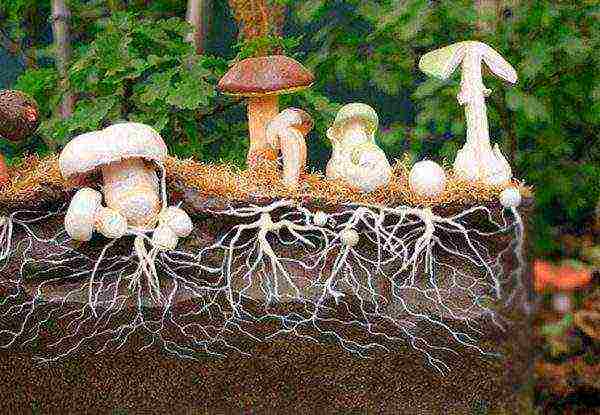 Sectional diagram of mushroom growth from mycelium
Sectional diagram of mushroom growth from mycelium
Other ways to grow mushrooms at home
In addition to the main ones, there are also additional ways of growing mushrooms. True, they do not bring such a large-scale result and are used mainly by children as experiments. For example, some types of mushrooms can be grown on logs. For this logs up to half a meter long are cut from hardwood. This must be done at least 2 weeks before settling with mycelium.
In the resulting blank, holes are made in a checkerboard pattern at a distance of 10 cm. After that, the sticks with mycelium must be sealed. A hammer can be used for this procedure.
Before starting work, you must disinfect your hands and make sure that there is no debris in the holes.
The logs filled with mycelium are placed in the basement and wait until it fills the entire space. The procedure is lengthy and can take up to 1 year. Temperature and humidity are considered key conditions.
A known method of growing mushrooms on coffee grounds. It contains many trace elements:
- manganese;
- potassium;
- magnesium;
- nitrogen.
 Growing mushrooms on stumps
Growing mushrooms on stumps
This environment is ideal for oyster mushrooms. In addition, the coffee grounds do not need to be sterilized again. The disadvantage of this method is that it is very difficult to get a large amount of freshly drunk cake at home. We'll have to ask him at the nearest cafe. The growing container can be regular freezer bags or ice cream containers.
The mycelium must be mixed with the cake, and then the container must be tightly closed. It can be stored under the sink. Germination time will be about 1 month. Once the surface is white, cut a small hole in the top of the bag. Through it, it is necessary to spray with water 2 times a day. After a week, you can see how small mushrooms begin to grow.
Growing porcini mushrooms and other species at home for beginners is a very exciting and useful activity. The needs of your family can be fully satisfied, even without special skills and large areas. The main thing is patience and a desire to see the result. After all, you can grow them all year round!
3 parts: Basic growing method Growing mushrooms on coffee grounds Alternative growing methods
Growing mushrooms at home is a task that anyone interested in growing food for their own consumption should tackle at least once. Mushrooms are a beneficial addition to any diet because they are low in calories and fat, but high in fiber and potassium. Plus, they're easy to grow at home. Mushrooms are best grown in an area where temperature and conditions are easy to manage. Knowing how to grow mushrooms at home will help you carefully manage your growing conditions.
Part 1 The main method of growing
-
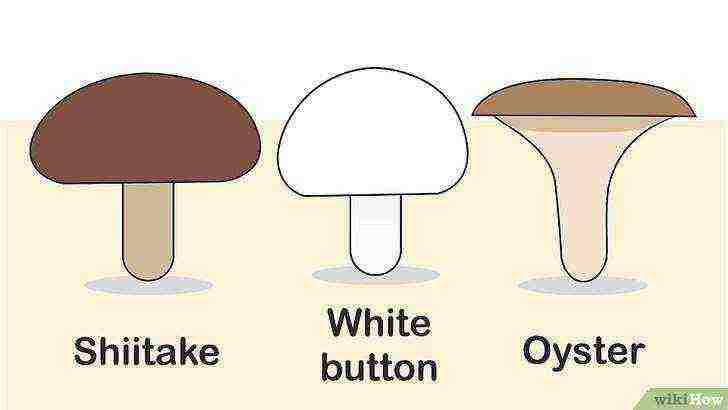 Choose the type of mushroom to grow.
Choose the type of mushroom to grow.
There are 3 types of mushrooms that are easiest to grow at home: oyster mushrooms, champignons and shitaki. The cultivation method for each type of mushroom is similar, but the ideal growing medium is different.
- Oyster mushrooms are best grown in straw. Shiitaks grow better on deciduous sawdust, and mushrooms grow on compost manure. These different nutrient media reflect the different nutritional needs of each species. However, each of the 3 species is easy enough to grow in sawdust or straw.
- The choice of mushrooms for growing is a matter of taste. You need to grow the mushroom that you want to eat.
-
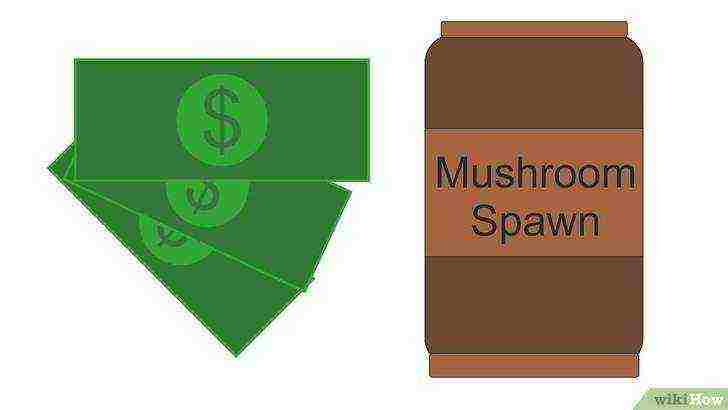 Buy mycelium.
Buy mycelium.
Myceliums are sawdust permeated with fungal mycelium - in fact, the root structure of the fungus. They are used as seedlings of plants to promote growth.
- You can buy high quality mycelium from an online store, gardening store, or other specialty organic store.
- Buy the mycelium, not the spores. Some stores also sell spores that look more like plant seeds (rather than seedlings). Growing mushrooms from spores takes more time and practice and is best suited to a seasoned mushroom grower.
- Sterilize the culture medium.
If you grow mushrooms in straw or sawdust, you must sterilize this substrate before sowing the mycelium. This is done in order to kill any microorganisms that might compete with the mycelium.
- To sterilize the medium, place it in a heat-resistant bowl and add enough water to make the straw or sawdust damp. Place the bowl in the microwave and heat it on high power for two minutes or until the water has boiled away.
- This kills all microorganisms, making it a safe breeding ground for mycelium to be accepted. You may have to work in batches to sterilize all straw or sawdust completely.
- Heat the substrate to spread the mycelium in it.
The mycelium must be thoroughly spread in a nutrient medium for the mushrooms to grow. Warm temperatures stimulate growth.
- After choosing a substrate for your mushroom species, place a few handfuls of it in a baking sheet. A shallow baking sheet with a large surface area is ideal for growing mushrooms.
- Stir the mycelium into the substrate with a sterilized spoon or similar. Place the baking sheet on an electric pillow set at 21 ° C. This is the ideal temperature to stimulate growth.
- Leave the unit in a dark environment such as a closet for three weeks. This will allow the mycelium to spread in the nutrient medium.
- Place the substrate in a suitable location.
After three weeks, place the substrate in a dark and cool place (about 13 ° C). As a rule, a basement is suitable for this, but in winter, a closet or drawer in an unheated room will do.
- If you notice green or brown spots on the substrate (like moldy bread), remove the spots and discard.
- Pour a handful of soil onto the substrate and sprinkle everything with enough water to thoroughly wet. You can cover the baking sheet with a damp towel to prevent moisture loss.
- You can place a low heat lamp next to the baking sheet. It will replace the sun, and the mushrooms will begin to reach for it and grow upward, which will further facilitate their collection.
- Keep the mixture moist and cool while the mushrooms are growing. Check it periodically and spray with water as needed.
- Mushrooms prefer coolness. The most important thing is not to let them overheat. At temperatures below 21 ° C, the mushrooms should grow excellently.
- Harvest when the mushrooms are fully grown.
After about three weeks, you will have small mushrooms. Maintain moisture, coolness, and darkening to encourage their growth.
- When the mushroom caps are completely detached from their legs, they can be collected. You can pick mushrooms with your fingers, but you risk damaging newly developing mushrooms below the surface. Better to use a sharp knife to cut the mushrooms at the base of the stem.
- Rinse the mushrooms before cooking. The harvested mushrooms can be stored in a paper bag in the refrigerator for up to seven days.
Part 2 Growing mushrooms on coffee grounds
-
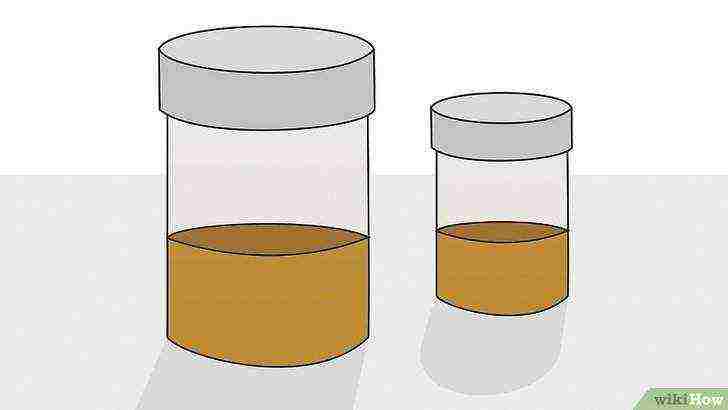 Take out the coffee grounds.
Take out the coffee grounds.
Growing mushrooms from coffee grounds is an interesting project that reuses coffee grounds that would otherwise go to waste. Coffee grounds are an excellent breeding ground for mushrooms (in particular oyster mushrooms), as they are already sterilized during the coffee brewing process and are full of nutrients.
- For 500 g of mycelium, you will need 2.5 kg of fresh coffee grounds. The best way to get that much fresh coffee grounds (brewed on the same day) is in a café and kindly ask. Most likely, they will gladly give it to you.
-
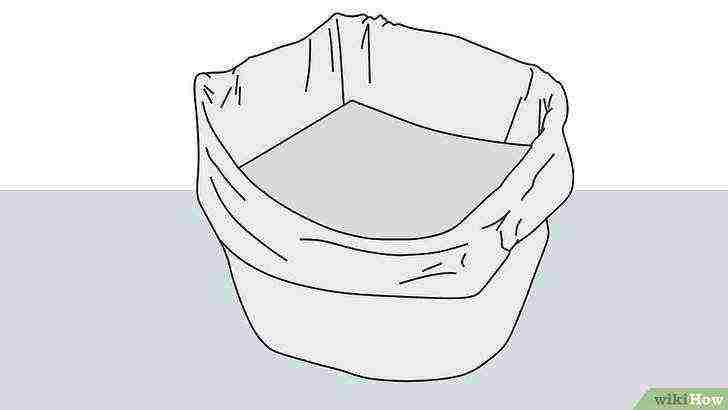
Find a container for mushrooms. It is best to use a special filter bag that can be purchased with the myceliums. If not, you can use a large airtight freezer bag, a cleaned milk carton, or an ice cream carton with four holes punctured in the sides.
-
Transfer the mycelium to a container. Wash your hands thoroughly with antibacterial soap, then stir the mycelium into the coffee grounds, crushing it with your hands to distribute it evenly. Place the planted coffee grounds in a plastic bag or container and seal tightly.
- Place the mycelium in a suitable environment.
Place the bag or container in a warm, dark place between 18 and 25 ° C, such as under a sink. Leave it on for about three to four weeks until the contents are completely white due to the mycelium settling in the coffee grounds.
- If green or brown spots appear on the substrate, cut them out to avoid poisoning later.
-
Move the mushrooms. When the contents of the bag or container become completely white, move it to a bright place (but not in direct sunlight) and cut a 5x5 cm hole on top.Moist the contents of the container by watering it twice a day to prevent drying out - the mushrooms will not grow too dry conditions.
- Harvest the mushrooms.
Over the next five to seven days, the tiny mushrooms will start to sprout. Keep hydrating them with water and they will double in size daily. When the mushroom caps begin to curl slightly upward, they can be collected.
- When the mushrooms stop sprouting, plant coffee grounds in your garden, cover with bark mulch or compost, and new mushrooms may sprout depending on the weather.
Part 3 Alternative cultivation methods
-
 Grow mushrooms from the kit.
Grow mushrooms from the kit.
Growing mushrooms from a ready-made kit is a fun and easy way for beginners. Such kits usually consist of plastic bags filled with sterilized and seeded straw or soil. All you need to do is store the bag in the right conditions for seven to ten days until you have your homegrown mushrooms.
- The sets usually contain the most common varieties of mushrooms such as champignons, shiitake mushrooms and oyster mushrooms.
- To start growing, simply open the bag and place it in a well-lit area out of direct sunlight, such as a shaded window sill. The kit can be kept at room temperature, but it needs to be moistened daily with water to keep the humidity high. Some kits have plastic tarps to cover the bag and keep the humidity level.
- Mushrooms will begin to germinate after seven to ten days, but within three months they may suddenly start growing two or three more times.
- After you have collected all the mushrooms, you can bury the substrate with mycelium in the garden, sprinkle with bark mulch, or in a compost heap. Then, depending on the weather conditions, the mushrooms will start growing in this place.
- Grow mushrooms on a log.
Another interesting way to grow certain types of mushrooms - such as reishi, ram mushroom, shiitake, oyster mushrooms - on a log. Birch plugs, completely sown with mycelium, are stuck into a piece of log. Stoppers can be obtained online and from specialized mushroom spore suppliers.
- The first thing to do is find a suitable log for growing mushrooms. You will need non-scented deciduous logs such as maple, poplar, oak, or elm. They should be 90-120 cm long and no more than 35 cm in diameter. Cut them out at least two weeks before clogging in order to destroy the natural antifungal properties of the tree.
- To "populate" a piece of log 90-120 centimeters long, you will need about 50 plugs. Use a 5/16 ″ drill to insert the plugs. Make holes 5 cm deep throughout the log in a checkerboard pattern. The distance between them should be about 10 cm. Insert birch plugs into the holes and hammer them in to seal them completely.
- If you plan to leave the log outdoors, you will need to seal the holes with cheese wax or beeswax to protect the plugs from insects and harsh weather. If you will be storing the log at home, in a garage or basement, this is not necessary.
- Over time, the mushroom mycelium will spread on the birch plugs throughout the log until the entire piece of wood is inhabited. After complete settlement, the mushrooms will begin to sprout from the cracks in the log. This usually takes 9-12 months, but depending on the temperature and humidity, the mushrooms should appear again from year to year.
Advice
- For more information on growing mushrooms at home and outdoors, read this article.
What do you need
- Mycelium
- Straw, sawdust or manure
- Baking tray
- Heating pad
- Potting soil
- Sprinkler
- Water
- Towel
Article Information
This page has been viewed 84,808 times.
Was this helpful?
Supporters of a healthy diet and just curious gardeners are attracted to growing mushrooms at home. It allows you to supplement the family's diet with environmentally friendly, low-calorie foods that are almost fat-free, but rich in fiber and potassium. Self-cultivation of mushrooms only seems difficult and troublesome. Even beginners can grow them at a minimum cost. Knowledge of the technology and compliance with the requirements of mushrooms for keeping conditions will allow you to get a good harvest.
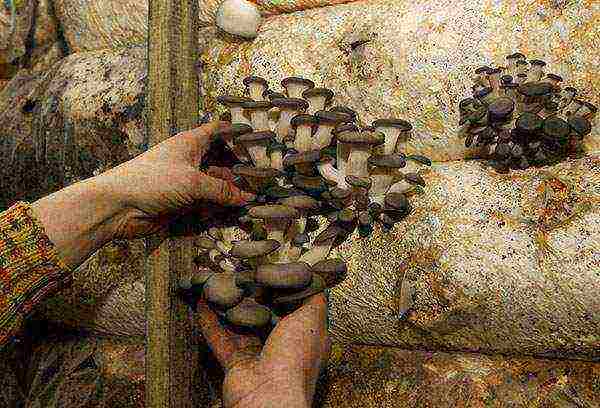
Substrate selection
Most often, three types of mushrooms are bred at home:
- oyster mushrooms;
- Champignon;
- shiitake.
The rules for growing them are almost identical. The difference can be traced only in the composition of the nutrient medium. Oyster mushrooms feel most comfortable on straw. For shiitake, wood is more suitable - sawdust of deciduous trees. Champignons develop fastest in compost. It is prepared in a special way by mixing the following components:
- manure (horse manure is better, but any other can be used);
- fresh straw made from rye or wheat;
- mineral compounds such as gypsum, chalk, meat and bone meal, brewer's grains, ammonium nitrate, urea, superphosphate.
Although these types of mushrooms have different nutritional requirements, they cannot be called too strict. With proper care, each of them will delight with the harvest in chopped straw or sawdust. The nutrient medium must be of high quality. Evaluate it by external signs: cleanliness, dryness, absence of mold, impurities and odors.
The mushrooms will bring the greatest harvest on wheat straw. On rye or barley, they will also delight you with their abundance and rapid growth. It is better not to take oat straw for growing mushrooms. When growing oyster mushrooms, sunflower husks can be used. Another requirement is imposed on it: it must be fresh. Aged husk is an excellent breeding ground for pathogenic microbes.

Mycelium or fungal spores?
The next step is the acquisition of mycelium, which will serve as material for sowing, seedlings. In the scientific literature, it is called mycelium. It is a base containing many germinated fungal spores. After placing the mycelium in a nutrient substrate, it begins to grow actively. First, thin white filaments are formed, which, as they develop further, turn into mushrooms.
The basis of the mycelium can be:
- rye grains;
- wooden bars;
- sawdust.
So that the experience of home mushroom growing does not bring disappointment, you need to purchase high-quality planting material. Specialized shops will come to the rescue here. The cost of wood with viable fungal spores is higher than that of grain mycelium. But she has an important advantage - a higher plant resistance to viral diseases.
On sale there are also just spores of mushrooms. Champignons or oyster mushrooms are also obtained from them. This process will be like growing any garden crop from seed. When planting spores, you will have to be patient, because much more time will pass before harvesting. This method of growing mushrooms will require a certain skill, which can only be obtained with practice. Therefore, it is not suitable for beginners.

Preparation of the culture medium
The nutrient medium is prepared for sowing the mycelium by sterilizing it. This is an important step that cannot be skipped. Finely chopped straw or sawdust can contain pathogens that can destroy plantings. They will die during the sterilization process. It is not difficult to carry out the procedure at home. After filling a heat-resistant bowl with straw or sawdust, add water to it so that the material becomes damp. Then the dishes are placed in the microwave oven, turning it on at maximum power. Warm up the nutrient medium until excess water evaporates. This usually takes about 2 minutes.
Advice
If there is a lot of straw or sawdust, sterilization is carried out in batches.
The productive use of mycelium involves its thorough distribution in a nutrient medium. So the mycelium will give more harvest. At this stage, warmth is important to disputes. It stimulates their growth. Therefore, the nutrient medium is heated using an electric pillow.
Part of the treated straw or sawdust is placed on a baking sheet or in a shallow but wide saucepan. After scattering the mycelium on the surface of the material, mix it slightly with your fingers. The dishes with the nutrient medium are placed on the electric pillow, setting its temperature at around + 21 ° C. Then the structure is placed in a place securely protected from light. A wardrobe is ideal for this.Keep the mycelium in it for 3 weeks. During this time, it will spread in straw or sawdust.
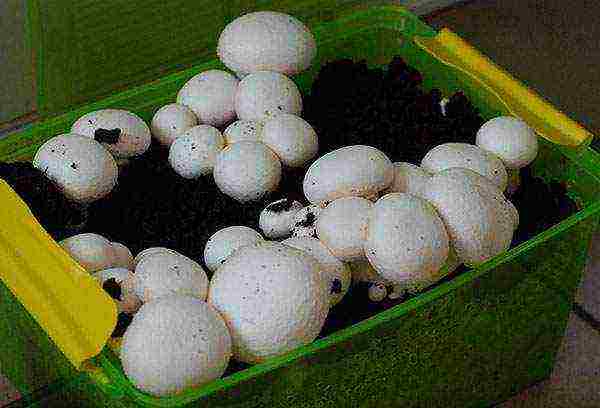
Requirements for growing conditions
For the development of mushrooms, 3 conditions are necessary:
- high air humidity (around 90-95%);
- ventilation;
- temperature regime.
If the incubation period is transferred to the mushrooms in the heat, then with the entry into the growth phase they begin to need coolness. The temperature is comfortable for them at the level from +10 to + 15 ° C.
Therefore, the experience of home mushroom growing in an apartment is unlikely to be successful. If you have a glazed balcony, you can put the seeded mycelium on it. But in order to create an optimal microclimate there for him, you will have to make a lot of efforts.
There is one more factor that must be taken into account when thinking about growing mushrooms in a residential environment. When they mature, they release many spores into the air. If inhaled, they can provoke a serious allergic reaction: cough, runny nose, watery eyes. In the room where mushrooms grow, you need to be in a gauze bandage, or better - in a respirator. Long-term daily inhalation of spores can cause asthma. It is worth noting that only fully ripe mushrooms are thrown away. Usually, the crop is harvested earlier, not allowing their caps to overgrow. Having isolated the spores, they begin to dry out and become unsuitable for food. It will be more productive and safer to grow mushrooms in a basement or similar premises (cellars, sheds, garages).
After removing from the cabinet, the culture medium with the seeded mycelium is sprinkled with a thin layer of soil and well sprinkled with water. Professionals advise covering the planting container with a damp cloth folded in several layers or a towel. This will help avoid rapid evaporation of the water. The state of the mixture is carefully monitored, preventing it from drying out and overheating.
It will be possible to notice small mushrooms after 3 weeks. Their readiness for cutting is determined by their caps. You can start harvesting when they finally separate from the legs. A typical mistake for beginners is trying to pick mushrooms with their hands. In this case, the mycelium is often injured. New mushrooms that are still inside the nutrient mixture are also damaged. To avoid this, the crop is cut with a sharp knife. The collected mushrooms can be cooked immediately or put in a paper bag and put it in the refrigerator. The maximum storage time is 7 days.
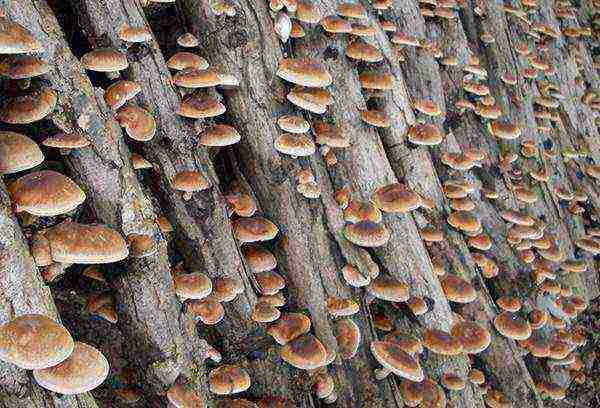
Mushrooms on the tree
Some mushrooms (boletus, shiitake, chanterelles, reishi) are grown on wooden blanks - logs. They are clogged with corks seeded with mycelium, which are made from birch. It is not difficult to get such material, it is on sale. Logs are cut from deciduous trees. Poplars, maples, elms, oaks are well suited for this. The length of the blanks should be 30-50 cm, and their diameter should be 20-50 cm. Saw them in advance, no later than 2 weeks before settling with mycelium, since fresh wood has high antifungal properties.
Plugs are inserted into holes, which are drilled with a drill to a depth of 5 cm, without touching the core of the log. They are made in a checkerboard pattern throughout the workpiece, retreating 10 cm between them. The sticks with mycelium are compacted. You can use a hammer for this.
Advice
Before starting work, wash your hands thoroughly with soap. In the process, they carefully monitor so that no debris gets into the holes.
Then the logs are placed in a basement or other room where mushrooms are to be grown. The mycelium will eventually spread from the birch plugs, completely populating the workpiece. When this happens, the mushrooms will begin to sprout into the log from the cracks. This process usually takes 9-12 months. It is strongly influenced by external conditions - temperature and humidity.
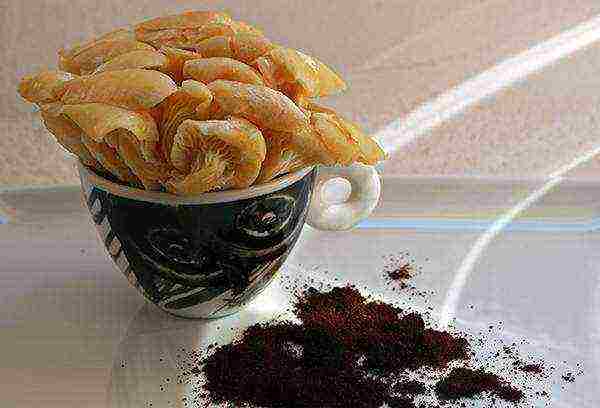
Alternative way
Waste-free practitioners prefer to use coffee grounds for growing mushrooms. It contains nitrogen, manganese, potassium, magnesium. In such a nutrient medium, mushrooms develop quickly, it is ideal for growing oyster mushrooms.The advantage of coffee pomace is that it does not need additional sterilization. The one that he passed during the brewing is enough. But this method is not for everyone. The reason is simple: mycelium can only be sown in fresh grass. It should be brewed during the day. It is not easy to get such a volume of drunk coffee at home, but there is a way out - to ask for cake in the nearest cafeteria.
Next, you need to prepare the landing container. Special durable bags made of geotextiles are available for sale. But mushrooms can also be grown in regular freezer bags or milk cartons, as well as in ice cream boxes. Only 2 conditions must be met: the container must be clean and roomy.
The mycelium is evenly distributed over the surface of the coffee grounds, slightly mixing it into the cake. Do this with clean hands, washed with antibacterial soap. After sowing the drunk coffee, it is placed in a container or bag and tightly closed. Then it is placed in a closet or under the sink. For germination, mushrooms need darkness and warmth (+18 to + 25 ° C). In such conditions, the thick should lie for about 3 weeks.
When the mycelium completely populates it, it will turn white. Then the cake is placed in a bright place, shading it. A 5x5 cm hole is cut in the upper part of the bag. The culture medium is sprayed with water in the morning and in the evening. It should not dry out, otherwise it will not get a crop. After 5-7 days, small mushrooms will appear from the coffee cake. They will grow literally before our eyes. The main thing is not to forget about hydration. Whitened coffee grounds can be planted on site by burying it in compost or covering it with bark.
Protein-rich mushrooms have become an indispensable ingredient in many dishes. They are added to salads, snacks, scrambled eggs, cereals, soups, roasts, pilaf, stews, hodgepodge, sauces. They go well with meat, fish, liver, pasta, vegetables. Few can resist pies and other pastries with mushroom filling. You can endlessly experiment with them in the kitchen, discovering more and more new flavor combinations.
There is nothing difficult in growing mushrooms for a family or for sale. All they need is a comfortable environment: a nutrient medium, temperature conditions, high humidity and ventilation. They don't have to pay much attention. If you want and have a minimum of knowledge, it will not be difficult to achieve success in home mushroom growing.
Mushrooms are a natural source of protein and valuable vitamins. Growing mushrooms at home for beginners is a difficult but exciting process that bears good fruit. The finished product can be consumed on its own or sold.
The technology of growing mushrooms at home
Mycelium for growing mushrooms
Organizing the right mycelium takes almost half the time it takes to grow mushrooms. Growing experts prefer their own mycelium. Otherwise, the abundance and speed of crop emergence will depend on suppliers who do not always perform perfectly. A high-quality mycelium can be grown on wooden sticks or grain substrates. Each type of mushroom requires a different approach.
Mushroom Growing Kit
Today, there are kits on sale that allow you to grow mushrooms with no effort. Most often these are boxes with oyster mushrooms. Russian instructions are attached, so you will not get confused in the process and you will definitely get a harvest. The used substrate will be used for fertilization. According to the manufacturer's recommendation, a temperature of 14 to 22 degrees is needed. The box gives 3 harvests, and between them there is a pause of only a week, during which time the substrate is restored. Home care consists of regular watering. The cardboard container has dotted lines to create slots, a linen towel, a watering device, a thermometer with a magnet, and the mushroom block itself.
Mushroom growing blocks
Mushroom blocks are handy polyethylene bags. The dimensions of the packages may vary. Today 900 x 350 mm packages are in demand. The manufacturer fills the bags with substrate.It is a highly nutritious medium for the growth of fungi. Also in the package there is seed mushroom material. If the block is placed in the right conditions, then a rich harvest of quality mushrooms will soon appear. Most often it is oyster mushroom. One block costs from 100 rubles.
Growing mushrooms in a greenhouse
To grow mushrooms in greenhouses, you need to choose and prepare the right greenhouse design. Most often, dim light and humidity up to 90% are recommended. For cultivation of champignons, greenhouses are best suited, consisting of 4 flanges, where there is heating - gas, stove or electric. Oyster mushrooms grow well in greenhouses. For mushroom greenhouses, fog sprayers, ventilation systems, and a manual or mechanical straw chopper are often purchased.
mushrooms can be grown in a crush, in a greenhouse, in a vegetable garden, in bags
Cultivation of champignon mushrooms
Conditions for growing mushrooms in the basement of the house
Champignons don't need light, so they can grow in dark basements too. Mushrooms require good ventilation with an insect screen, but no drafts. Installation of forced fans above drawers and cleaning filters is permissible. Heating is on during the winter months. Humidity is monitored by a hygrometer and a thermometer, to reduce humidity, ventilate the room, to increase it, irrigate floors and racks. The growth of mycelium occurs at a temperature of 23 degrees, the fruits grow at 16-17 degrees. Thus, it is better to have 2 zones with a stable temperature - in one, incubation takes place and the mycelium grows into the substrate, and in the other, a crop is created.
How to grow mushrooms in your basement?
It is obligatory to treat the premises from mold and parasites. Natural compost can be made from horse manure, superphosphate, urea, gypsum and ammonium nitrate. Alabaster, straw, ammonium sulfate and chalk are also used. The compost takes about a month to prepare; it heats up during fermentation. When growing mushrooms, you need a special compost with a temperature below 25 degrees. The soil is easy to purchase ready-made. Mycelium is purchased from gardening stores or online. Growing mushrooms will be successful if 1 sq. m. of the substrate will have 400 g of spore grains and compost mycelium - about 500 g. Planting of the compost mycelium of mushrooms in the substrate is carried out in small pits located at a distance of 20 cm. If these are spores, they scatter on the surface. It is important to know that during the incubation period, the humidity in the basement is maintained at 70-95%. You can cover or spray the substrate.
Mushroom harvest
The optimum temperature for the growth of mycelium is in the range of 20-27 degrees. Young mushroom filaments can be seen after 10-12 days. Next, you need to pour 4 cm of earth on the substrate (soil mixed with peat, limestone), wait another 5 days. Spray the planting with water from time to time. When the incubation phase ends, the temperature is lowered to 12-17 degrees and the growth of mushrooms starts. After 3-4 months, the harvest takes place. Mushrooms are removed by twisting, without cutting off, cover the place of the mushroom with soil. The crop is harvested at a time when a white film has not yet appeared on the cap, there are no brown plates. Active growth lasts 1-2 weeks, you can get 5-8 harvests. Best suited for growing at home varieties two-ring, double-stemmed, Hauser A15, meadow champignon, Somycel 512.
Equipment for growing mushrooms
Large mushroom producers use expensive equipment. For example, hot water boilers, steam generators. The work is performed by machines and mechanisms, such as conveyors, soil rippers, irrigation devices, hoists with a winch. And manufacturers are also forced to purchase a lot of ventilation equipment, for example, centrifugal fans and air heaters, heat exchangers and air purification systems.
Growing oyster mushrooms
Conditions for the growth of oyster mushrooms
If you grow oyster mushrooms in their natural environment, then the harvest will be only once a year, so the intensive method of growing on a special substrate is popular.The basement for mushrooms must be clean, free of pests and mold, with good ventilation, temperature 10-20 degrees, humidity 85-95%. Typically, sealing and heating of the room is required. First you need to purchase mycelium and substrate - it includes hay, buckwheat husk, stems, wood chips. The product is sold in packages. For looseness and saturation with air, the substrate is treated by dry or wet blowing with steam, boiling for 1.5 hours in hot water. You can boil the substrate in a bag with holes. Good drying within 2 days will protect against mold. Then grind and mix the substrate. The mycelium is stored for 6-9 months at a temperature of 3-4 degrees (not higher than 20 degrees).
Growing mushrooms in bags
Keep the mycelium at room temperature for 1 day. Mash directly in the package. Mycelium is planted and mushrooms are grown in different rooms or behind a partition. We open the package under sterile conditions. Mix the mycelium and the substrate, there should be 1.5-3% of the mycelium. The mixture is packed in plastic bags, each weighing 10-15 kg. For the basement, 5 kg bags are better. Holes must be made in each bag. The cuts are made with a clean knife, at an angle of 45 degrees, 50 mm long. Place the bags in an incubation zone with a temperature of 25 degrees, not higher than 30 degrees. Do not ventilate the room. The free area between the bags is at least 5 cm. The bags are not stacked on top of each other. Incubation lasts 18-25 days, then we put the bags vertically for cultivation.
Growing mushrooms as a business
If the temperature is up to 20 degrees, mushrooms with dark caps will grow, up to 10 - with light ones. For the harvest, you need lighting - 5 W per 1 sq. m. Water the mushrooms with warm irrigation 1-2 times a day. To prevent spores in the air from causing allergies, you need to keep the mushrooms away from housing. The harvest will appear in 1.5 months. When you pick the mushrooms, the next batch will ripen in 14-21 days. To accelerate the growth of the crop, you need to sort out the substrate and cut off the whole leg. With the right approach, oyster mushrooms grow for 6 months. If mold appears, remove the bag and make fertilizer out of it. A successful oyster mushroom business requires investment, but it all pays off. 100 sq. m. plantings per year will bring up to 4 tons of harvest. A kilogram of mushrooms costs about $ 1.50. To grow your business, purchase a set of tools and follow the instructions. Special blocks and other useful accessories are sold to facilitate the process and ensure a rich harvest.
Growing mushrooms on stumps
If you populate garden stumps with mycelium, then it will be possible to harvest the crop for 5 years. The stump will gradually degenerate into dust. Not only oyster mushrooms grow well on stumps, but also mushrooms. To saturate the stump with mycelium, you need to grind and soak mushroom hats in warm rainwater. There is also another method - a section of a forest stump where mushrooms grew, remove and nail to a garden stump. Moisten the transplant area. To create comfort for the growth of mushrooms, shade is needed; for this, monards, rudbeckia and ferns are planted around the perimeter of mushroom stumps. Stump dust is a good fertilizer.
Growing shiitake mushrooms
Planting mycelium in logs
The basis for growing mushrooms is felled logs of oak, chestnut, beech, hornbeam trees. The bars are selected healthy, 20 cm in diameter, 1.5 m long, with a moisture content of 35-70%. The bars are suitable for sowing mycelium for 1-3 months. For this, holes are drilled in a checkerboard pattern with a sterile 8 mm drill. Lay the rows of holes 10 cm from one another, space the holes 20 cm from one another. The depth of the holes is 50 cm. The substrate mycelium is laid under wooden plugs, which are hammered in with a hammer and covered with paraffin or wax. Put all the blanks in a woodpile, place it in the greenhouse. But also a forest, a greenhouse, a hangar is suitable for incubation.
Fruiting shiitake
Correct incubation takes place at 20-26 degrees, 6-18 months. Moisture is needed to stimulate fruiting.Mushrooms will grow for 2-5 years; for bars of different sizes, the active period may differ. In a warm environment, shiitake produce fruits from 2 times a year. After 2 months, the logs are soaked for rest. This technique is ideal for wet regions. The best place to start a plantation is a draft-free place protected from the sun.
Growing shiitake bags
The bagging technique is applicable not only to oyster mushrooms, but also to shiitake mushrooms. A normal substrate can be made from sawdust obtained from deciduous trees. An important fact is the size of the fractions of the sawdust mass. Fractions should not be very small, otherwise the mass will clump and there will be no full air movement. A humid and clean microclimate should be created in order to get a high-quality harvest.
Cultivation of porcini mushrooms
What is needed to grow mushrooms on a mycelium plot?
Porcini mushrooms are successfully cultivated in natural soil. Therefore, a personal plot is the best plantation. The downside is that you can only harvest once a year. Mycelium can be purchased at the store. It is laid out in May-September under conifers, not old trees. You will also need properly prepared compost, leaves, moss and twigs. One site can take up to 1.5 m, the tree will be in the center.
Planting porcini mushrooms in the garden
We remove 20 cm of soil. Place a 2 cm layer of compost or soil rich in peat. The mycelium is laid out in a staggered sequence, at intervals of about 30 cm. Cover the planting with straw and water. The optimum soil moisture is 40%. The established mycelium will yield a harvest in a year. Porcini mushrooms in the country will grow for 3-4 years. Subject to fertilization - up to 7 years.
Porcini mushrooms indoors
If porcini mushrooms are grown indoors, then it is necessary to adhere to the temperature range of 8-12 degrees. You also need enhanced ventilation, periodically turn on the lighting and keep the humidity at 90-92%.
Growing mushrooms in the country from hats
Hat technology is also available in the garden. Seed material is 10 mature mushrooms, which have 20 cm caps with greenish flesh. Soak the mushrooms for 24 hours in a bucket of rainwater, then knead them by hand without removing them from the bucket. Separate the infusion with spores from the mushroom pulp using a sieve. Pour the solution onto a bare plot of land, proportions - 2 liters per square meter. m, then put the mushroom cloth, sprinkle with earth and water. Cover the material in winter. Watering once a week. When the mycelium takes root, after 1-2 years, 2-5 kg of the crop will appear. Porcini mushrooms will grow for 3-4 years.
on the garden plot, you can grow mushrooms of different varieties if you bury the mushroom caps and water them
Growing Kombucha
How to make kombucha from tea leaves?
Kombucha is grown to create a delicious and healthy drink. You only need a few items - a clean 3-liter jar, black large leaf tea without additives and a kettle, cheesecloth, sugar and boiling water. First, brew 0.5 liters of boiling water, 5 tablespoons of tea, then filter the infusion with gauze. Pour strong tea leaves into a jar, cover with gauze, keep in a warm environment for 1.5 months. After a week, the infusion will exude a vinegar smell, after a week it will become weaker. A thin film will gradually stretch on the surface of the infusion - this is the rudiment of a kombucha. The mushroom will grow fat throughout its existence.
Growing a rosehip mushroom
To prepare a vitamin infusion, take 4 large tablespoons of dry or fresh rose hips, pour 0.5 liters of boiling water. Soak the tea for 5 days under the lid. Pour the rosehip infusion into a jar, mixing with tea leaves - 1 spoonful of large leaf black tea in 1 glass of hot water. Sweeten with sugar - 5 tablespoons, mix everything, stand for a day. Then filter the liquid through cheesecloth, wash the jar and pour the infusion into it again. Cover the container with gauze and wait 1.5-2 months, a mushroom should appear.
How to properly care for kombucha?
A healthy mushroom is always on the surface.The average volume of liquid in a can is 0.5 liters. When the mushroom grows, the volume increases to 3 liters. To add liquid, pour in the tea leaves - they are boiled, cooled, sweetened with sugar and poured into a jar. The amount of sugar is 2 tablespoons per 1 liter. The tea leaves do not harm the mushroom, but the sugar must be thoroughly dissolved, the crystals must not come into contact with the house mushroom. Washing the mushroom - once every 14-21 days. To do this, put the mushroom on a plate, filter the liquid, pour into a fresh jar. Wash the living, rounded substance with warm water. Brown color and stratification are a sign of illness. A healthy mushroom produces a delicious clear infusion.
As you can see, mushrooms are very different and cultivation technologies are different. You can make this wonderful product for yourself or develop a good home business on this basis.


